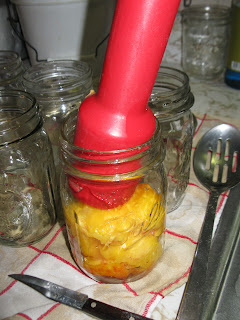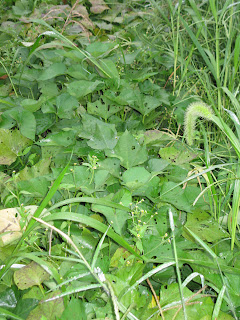In 1976 I was expecting our 3rd child. We lived in rural Nebraska, renting a house on a farm there. That is where I had my first garden, and that is where I learned to can food. Money was always in short supply, but we made it. My husband has always provided for us, and has worked very hard through the years. Now he is "retired" and he still works very hard here at home keeping us afloat. His "list" just gets longer and longer.
In those days, we only went grocery shopping once a month. I clearly recall finding some "lugs" of fresh peaches at the grocery store and we bought 2 of them for me to can. What riches! I had a nice canning instruction book and so, I canned them. The only problem was my little daughter, who was not yet 2-years-old, picked that day to be very unhappy. I put her in my baby back-pack and proceeded. I remember telling her that if she watched carefully, then next year I would let her can the peaches! I didn't realize until I finally sat down to rest that afternoon that she was sick. She had a fever and I discovered she had chicken pox. Poor little thing! I had many opportunities to be grateful for those peaches. Toward the end of the month, we would nearly run out of food, and the 2 little children I had at the time ate many a meal filled out with home-canned peaches.
Years later, a friend told me how to can peaches without using any sugar. Basically, you do it the same as for tomatoes. And now I will show you how.
First, get some peaches and let them get ripe:

Here is how to check for ripeness. Press your thumb into the flesh of the peach near the stem. If it is getting soft, it is getting ripe. Eat one to be sure it is as ripe as you want it to be. If it is not ripe enough, the skin will be difficult to take off:

Carefully wash and rinse your jars. I used pint jars this time, but you can also use quarts, if you like:

Put the "caps" in a small pan of water on the stove and bring to just below simmer. Let them sit there, keeping hot, while you get ready to use them:

Bring a large saucepan filled 3/4 with water to a boil:

Fill the sink with cold water:

You will need a sharp little paring knife:

Get the "rings" ready:

This is what I use to lift the caps from the hot water. It has a magnet on the end. But before I had this, I always fished them out with the tine of a fork:

You will need a large slotted spoon:

Carefully put some peaches into the boiling water and leave the heat on high for about 20 seconds:

Take them out with the slotted spoon:

And put them in the cold water:

Using your paring knife to help, slip the skins off the peaches. This is not a very good picture of the process, but you will see how easy and quick it is. If the skins don't slip off easily, either the peaches are not ripe enough, or you need to scald them a little longer.

Next, cut the peach in half, twist the two halves apart and remove the pit:

Place the peeled peaches, in halves or pieces (depending on the size and fit) into the jars:

I like to use wide-mouth jars, but if I don't have enough, I use regular mason jars and use this red thing to push them down. I think it came along with my Victorio Strainer. If you have wide-mouth jars, you can easily push the peaches down with your hand. The idea is to push them gently until the juice comes up some. I was able to fit 2 - 3 peaches in each jar:

Here is a full jar. When it is filled up to the bottom of the jar threads, carefully wipe off the rim of the jar with a damp clean cloth, put on the cap and screw on the ring firmly. Not too tight!

Here is one full and closed, ready to process:

Here are 10 pint jars in my steam canner. You can use a water bath canner, of course.

When the water is boiling in the water bath canner, then start counting the time. They need 25 minutes for pints and 30 minutes for quarts. Here they are after coming out of the canner.

Incidentally, leaving the sugar syrup out has advantages. It's less expensive to do, healthier of course, and they really do taste marvelous! They kind of remind me more of canned apricots after being canned like this in their own juice. You will love it! It is also much easier and quicker to do.
I have found that when canning anything, once you get your "system" set up, it's easy. Think it through carefully, prepare everything you'll need and proceed. Enjoy!
This post is linked at Wardeh's
Simple Lives Thursday #57 !
























































